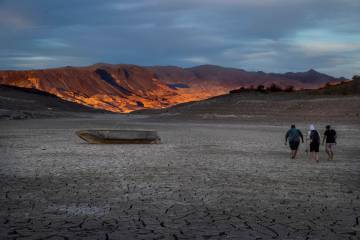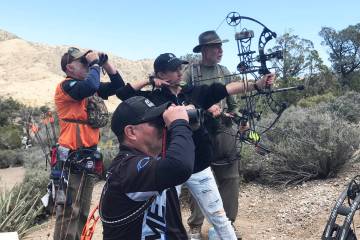Hunting challenge is leaving wilderness better than we found it
When the sun came up Monday morning, so, too, did the curtain on Nevada’s big-game seasons.
First on the list is the archery hunt for pronghorn antelope, which opened in units across the state Monday. That is just the beginning.
Over the next few months, hunting parties ranging in size from one person to many will spend time pursuing their quarry in Nevada’s wild lands. Some will camp in tents, others in recreational vehicles, and the rest in the comfort of a hotel room or someone’s home.
Regardless of our choice of accommodations, we will have some impact on the wild country we visit. Our challenge is to limit that impact on the places we visit and leave them in better condition than we found them.
That means cleaning up after ourselves and perhaps others who have been there before and chose to leave a mess behind.
One year, a camp just up the road from ours pulled out and left several bags of garbage piled neatly under a tree. Other than those bags, the camp was clean. The situation made no sense. Did they really think a garbage disposal service was going to send a truck by to pick up their trash?
Luckily for all of us, my good friend is the type of guy who will clean up after others to protect outdoor places for the rest of us. He loaded those bags into the back of his truck and kept the local wildlife from having a field day with their contents.
Perhaps the biggest threat we bring with us to Nevada’s wild lands is that of fire, especially given the amount of rain that fell across much of the state during the spring. That moisture brought life to the desert. In May, I traveled to South Fork Reservoir near Elko, and all along the way, I drove past grass and wild flowers in a variety of colors. It was beautiful.
Today, however, that spring vegetation is brown and dry, little more than fire starter blowing in the desert winds. There are six active fires in Nevada that have burned more than 184,000 of acres of wildlife habitat, some of it critical winter range.
While many fires are started by natural means, there are always those fires whose origins can be traced to human activity. In 2015, according to the U.S. Forest Service, there were 58,916 man-made fires that burned more than 2 million acres. That means those of us going afield this season need do so with fire prevention in mind. Begin by becoming familiar and complying with any fire restrictions that may be in place at your destination.
A common restriction limits campfires to developed campgrounds and picnic areas but permits the use of propane camp stoves outside of those areas. Even if a formal restriction isn’t in place, a little common sense can go a long way. Building a roaring campfire in hot, dry conditions is probably not the best idea.
If you do build a campfire, choose a place that is at least 15 feet from fuel sources such as dry grass, wood or your tent. Don’t forget to look over your head as well. You don’t want to build a fire that can reach the branches of a tree. And as we have always been taught, don’t leave a campfire unattended.
Plan your fire use so you can let the wood burn all the way down to ashes. This will make it easier to completely extinguish. When you are done, pour water on the ashes until the hissing stops. If you don’t have enough water to completely drown the fire, stir in enough dirt or sand to completely bury the embers.
The vehicles we drive can be part of the fire problem. Parts of the exhaust system can become hot, especially after a long drive across the desert. Make it a point to park where the ground is clear of dry grass and other debris. If you are using an ATV, be sure the spark arrestor is in place. It is there specifically to prevent wildland fires. Also, take time to be sure safety chains and other metal parts aren’t dragging from your car or truck where they can throw sparks into grasses.
Hunting season also means some of us will be sighting in our firearms, either at the range or in the field. To limit the chance of firearm-related fires, the National Shooting Sports Foundation is encouraging recreational shooters to refrain from using steel-jacketed or steel-core ammunition, tracer rounds or exploding targets.
Freelance writer Doug Nielsen is a conservation educator for the Nevada Department of Wildlife. His “In the Outdoors” column, published Thursday in the Las Vegas Review-Journal, is not affiliated with or endorsed by the NDOW. Any opinions he states in his column are his own. He can be reached at intheoutdoorslv@gmail.com.






















